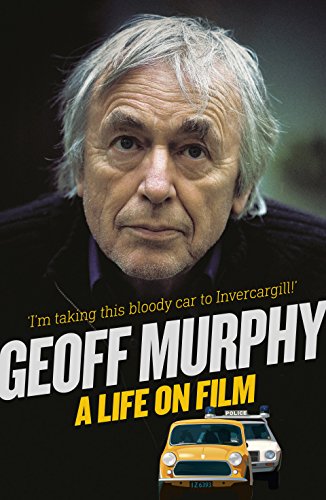 By GEOFF MURPHY (HarperCollins; 2015)
By GEOFF MURPHY (HarperCollins; 2015)
The late Geoff Murphy (1938-2018) was one of New Zealand’s top filmmakers, although you wouldn’t be able to tell that from his Hollywood output. The films he made in his native land include classics like UTU and THE QUIET EARTH, whereas his Hollywood productions, such as UNDER SEIGE 2 and FORTRESS 2, rank at the opposite end of the spectrum. How Murphy was capable to maintain such a varied artistic output, achieved while performing second unit direction on high profilers like DANTE’S PEAK, the LORD OF THE RINGS trilogy and xXx, is explained in this engaging memoir, certainly one of most interesting and underrated film books of the 2010s.
As revealed here, in suitably easygoing prose, Geoff Murphy was a product of the New Zealand counterculture. He liked to smoke copious amounts of weed, had a strong anti-authoritarian bent and lived for many years in a hippie commune. During the 1970s he was associated with actor-musician Bruno Lawrence and his band Blerta (or Bruno Lawrence’s Electric Revolution and Travelling Apparition), and also the MONKEES-like TV program of that name. Murphy also led a complicated love life involving multiple wives and mistresses, portions of which are set down here (I can’t help but suspect that a great deal of salacious info was deliberately left out).
Murphy’s debut feature, following a great deal of TV work, was 1980s anarchic action-comedy GOODBYE PORK PIE. American viewers (this one in particular) may find that film’s outsized popularity in its native land hard to fathom, but it was and remains a beloved New Zealand institution, featuring a line—“I’m taking this bloody car to Invercargill!”—that has become an iconic Kiwi catchphrase.
Murphy followed it with the 1983 period epic UTU, which he correctly identifies as his best film. It was a sizeable success, as was Murphy’s 1985 science fiction themed follow-up THE QUIET EARTH, but that didn’t improve his standing in the New Zealand film industry. Murphy relocated to Hollywood, where he directed RED KING, WHITE KNIGHT (1989), YOUNG GUNS II (1990) and FREEJACK (1992). It on the latter film, alas, that things went south, with Murphy clashing mightily with the producers and turning out a thoroughly mediocre product. Things didn’t improve much with UNDER SEIGE 2: DARK TERRITORY (1995), which ended Murphy’s directorial tenure in Hollywood.
Murphy describes his time in tinseltown in resolutely blunt and unforgiving terms. From the revelation that FREEJACK producer James Robinson replaced the film’s female lead Linda Fiorentino several weeks into production because “She doesn’t give me a hard on” to his admission of being kept from being fired from the calamitous production of UNDER SEIGE II by its star and co-producer Steven Segal (“I’m not even sure he was doing me a favor”), Murphy holds nothing back about how things are in Hollyweird.
He’s equally frank in his descriptions of the inner workings of the New Zealand film industry, which in Murphy’s view suffers from mismanagement and a lack of respect for its talent. Over half the book is taken up with Murphy’s work in NZ, meaning readers without a rooting interest in Kiwi filmmaking will probably be dissatisfied. For the rest of us, though, this is a terrific read that satisfies as both a gossip-laden tell-all and a straightforward chronicle of a highly unique, incident-heavy life.
